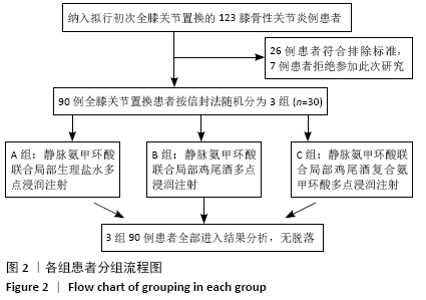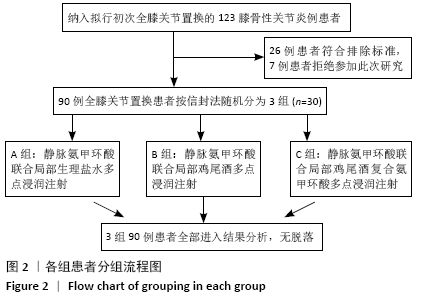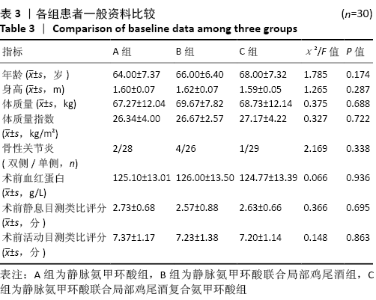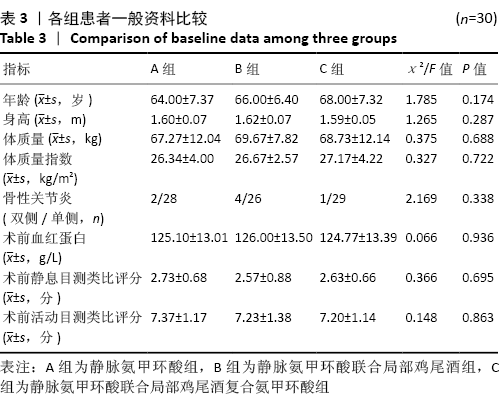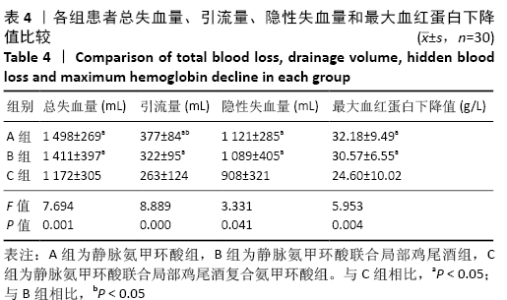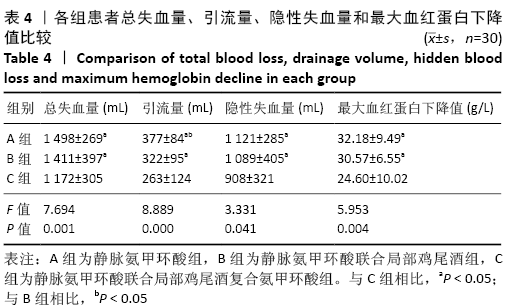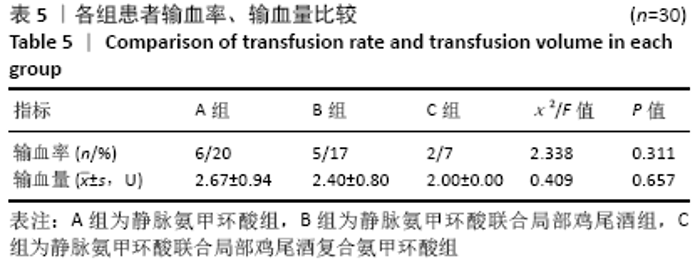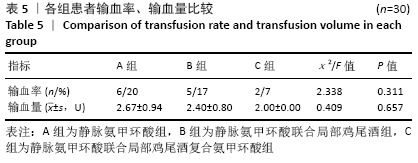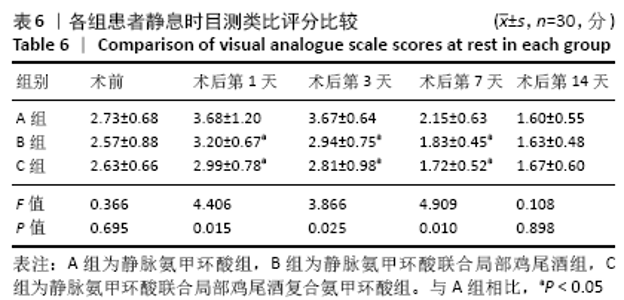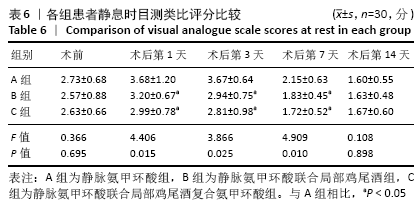Chinese Journal of Tissue Engineering Research ›› 2021, Vol. 25 ›› Issue (18): 2833-2839.doi: 10.3969/j.issn.2095-4344.3835
Previous Articles Next Articles
Effects of intravenous tranexamic acid combined with periarticular multipoint injection of tranexamic acid cocktail on blood loss and pain after total knee arthroplasty
Liu Jinlei, Yin Li, Zhang Yi, Wang Haitao, Li Zhuangyan, Xia Peige, Qiao Renqiu
- Department of Orthopedics, First Affiliated Hospital of Zhengzhou University, Zhengzhou 450000, Henan Province, China
-
Received:2020-06-29Revised:2020-07-03Accepted:2020-08-04Online:2021-06-28Published:2021-01-12 -
Contact:Yin Li, MD, Chief physician, Master’s supervisor, Department of Orthopedics, First Affiliated Hospital of Zhengzhou University, Zhengzhou 450000, Henan Province, China -
About author:Liu Jinlei, Master candidate, Department of Orthopedics, First Affiliated Hospital of Zhengzhou University, Zhengzhou 450000, Henan Province, China -
Supported by:the Key Scientific Research Project of Colleges and Universities in Henan Province, No. 20A310022 (to YL)
CLC Number:
Cite this article
Liu Jinlei, Yin Li, Zhang Yi, Wang Haitao, Li Zhuangyan, Xia Peige, Qiao Renqiu. Effects of intravenous tranexamic acid combined with periarticular multipoint injection of tranexamic acid cocktail on blood loss and pain after total knee arthroplasty[J]. Chinese Journal of Tissue Engineering Research, 2021, 25(18): 2833-2839.
share this article
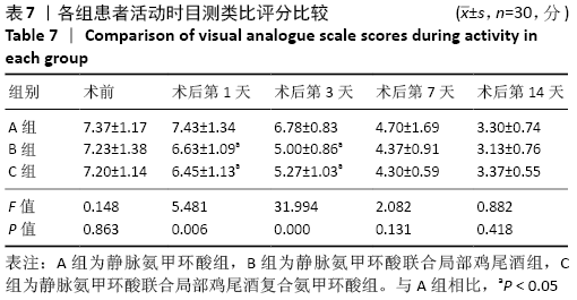
2.6.2 术后活动时的目测类比评分 术后第1,3天,3组间活动目测类比评分相比差异有显著性意义(P < 0.05),其中B、C组的目测类比评分明显低于A组(P < 0.05),而B组与C组之间差异无显著性意义(P > 0.05);术后第7,14天,3组间活动目测类比评分相比,差异无显著性意义(P > 0.05),见表7。 2.7 血栓及其他不良事件 所有患者术后第8天、第3个月行双下肢深静脉超声检查,均未出现下肢深静脉血栓;术后第6,12个月随访,均未出现下肢深静脉血栓及肺栓塞等临床表现;3组患者切口均一期愈合,术后第12天拆线出院,无感染病例。所有患者均未出现氨甲环酸及鸡尾酒配方药物相关不良反应。 "
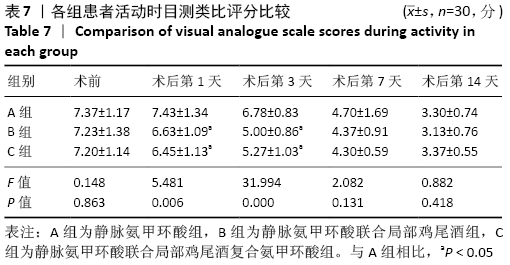
| [1] ISHIKAWA M, KURIYAMA S, ITO H, et al. Kinematic alignment produces near-normal knee motion but increases contact stress after total knee arthroplasty: A case study on a single implant design. Knee. 2015; 22(3):206-212. [2] JASPER LL, JONES CA, MOLLINS J, et al. Risk factors for revision of total knee arthroplasty: a scoping review. BMC Musculoskelet Disord. 2016;17:182. [3] ASAI N, ASAI S, TAKAHASHI N, et al. Factors associated with osteophyte formation in patients with rheumatoid arthritis undergoing total knee arthroplasty. Mod Rheumatol. 2020;30(5):937-939. [4] HARSTEN A, BANDHOLM T, KEHLET H, et al. Tourniquet versus no tourniquet on knee-extension strength early after fast-track total knee arthroplasty; a randomized controlled trial. Knee. 2015;22(2):126-130. [5] LIN SY, CHEN CH, FU YC, et al. The efficacy of combined use of intraarticular and intravenous tranexamic acid on reducing blood loss and transfusion rate in total knee arthroplasty. J Arthroplasty. 2015; 30(5):776-780. [6] XIE J, MA J, YAO H, et al. Multiple Boluses of Intravenous Tranexamic Acid to Reduce Hidden Blood Loss After Primary Total Knee Arthroplasty Without Tourniquet: A Randomized Clinical Trial. J Arthroplasty. 2016; 31(11):2458-2464. [7] 王宁, 翟文雯, 李民, 等. 超声引导连续隐神经阻滞对全膝关节置换术后镇痛效果影响的随机对照研究[J]. 中国微创外科杂志,2016, 16(10):870-874. [8] UESUGI K, KITANO N, KIKUCHI T, et al. Comparison of peripheral nerve block with periarticular injection analgesia after total knee arthroplasty: a randomized, controlled study. Knee. 2014;21(4):848-852. [9] 沈彬, 翁习生, 廖刃, 等. 中国髋、膝关节置换术加速康复--围术期疼痛与睡眠管理专家共识[J]. 中华骨与关节外科杂志,2016,9(2): 91-97. [10] 周宗科, 翁习生, 曲铁兵, 等. 中国髋、膝关节置换术加速康复--围术期管理策略专家共识[J]. 中华骨与关节外科杂志,2016,9(1):1-9. [11] PORTER SB, WHITE LJ, OSAGIEDE O, et al. Tranexamic Acid Administration Is Not Associated With an Increase in Complications in High-Risk Patients Undergoing Primary Total Knee or Total Hip Arthroplasty: A Retrospective Case-Control Study of 38,220 Patients. J Arthroplasty. 2020;35(1):45-51.e3. [12] CHARETTE RS, BERNSTEIN JA, SLOAN M, et al. One Versus Two Doses of Intravenous Tranexamic Acid in Total Knee Arthroplasty. J Knee Surg. 2019. doi: 10.1055/s-0039-1700805. [13] ZHANG S, XIAO C, YU W, et al. Tranexamic acid safely reduces hidden blood loss in patients undergoing intertrochanteric fracture surgery: a randomized controlled trial. Eur J Trauma Emerg Surg. 2020. doi: 10.1007/s00068-020-01387-0. [14] MA QM, HAN GS, LI BW, et al. Effectiveness and safety of the use of antifibrinolytic agents in total-knee arthroplasty: A meta-analysis. Medicine (Baltimore). 2020;99(20):e20214 [15] 孔刚, 马卫华, 张树栋. 氨甲环酸联合糖皮质激素局部使用对TKA术后CRP的影响[J]. 中华老年骨科与康复电子杂志,2019,5(6):317-321. [16] BUSUTTIL SJ, PLOPLIS VA, CASTELLINO FJ, et al. A central role for plasminogen in the inflammatory response to biomaterials. J Thromb Haemost. 2004;2(10):1798-1805. [17] ZHANG Y, MI F, ZHAO H, et al. Effect of morphine added to multimodal cocktail on infiltration analgesia in total knee arthroplasty: A meta-analysis of randomized controlled trials. Medicine (Baltimore). 2019; 98(41):e17503. [18] PEPPER AM, MERCURI JJ, BEHERY OA, et al. Total Hip and Knee Arthroplasty Perioperative Pain Management: What Should Be in the Cocktail. JBJS Rev. 2018;6(12):e5. [19] DANOFF JR, GOEL R, HENDERSON RA, et al. Periarticular Ropivacaine Cocktail Is Equivalent to Liposomal Bupivacaine Cocktail in Bilateral Total Knee Arthroplasty. J Arthroplasty. 2018;33(8):2455-2459. [20] 中华医学会骨科学分会关节外科学组. 骨关节炎诊疗指南(2018年版) [J]. 中华骨科杂志,2018,38(12):705-715. [21] DYSART S, SNYDER MA, MONT MA. A Randomized, Multicenter, Double-Blind Study of Local Infiltration Analgesia with Liposomal Bupivacaine for Postsurgical Pain Following Total Knee Arthroplasty: Rationale and Design of the Pillar Trial. Surg Technol Int. 2016;30:261-267. [22] NADLER SB, HIDALGO JH, BLOCH T. Prediction of blood volume in normal human adults. Surgery. 1962;51(2):224-232. [23] GROSS JB. Estimating allowable blood loss: corrected for dilution. Anesthesiology. 1983;58(3):277-280. [24] JAWHAR A, SHAH V, SOHONI S, et al. Joint line changes after primary total knee arthroplasty: navigated versus non-navigated. Knee Surg Sports Traumatol Arthrosc. 2013;21(10):2355-2362. [25] 刘昊, 刘宁, 柴宏伟, 等. 氨甲环酸对初次人工全膝关节置换术隐性失血与术后膝关节功能恢复的影响[J]. 现代仪器与医疗,2016, 22(1):107-109. [26] SEHAT KR, EVANS RL, NEWMAN JH. Hidden blood loss following hip and knee arthroplasty. Correct management of blood loss should take hidden loss into account. J Bone Joint Surg Br. 2004;86(4):561-565. [27] 景泽峰, 孙朝军, 李红, 等. 膝关节置换术中氨甲环酸止血机制的研究进展[J]. 世界最新医学信息文摘(连续型电子期刊), 2019,19(28):61-64. [28] 李新天, 王炜, 林进, 等. 改良鸡尾酒疗法对全膝关节置换术后疼痛控制的研究[J]. 中华骨与关节外科杂志,2017,10(4):298-301. [29] DUNN CJ, GOA KL. Tranexamic acid: a review of its use in surgery and other indications. Drugs. 1999;57(6):1005-1032. [30] WANG H, SHEN B, ZENG Y. Comparison of topical versus intravenous tranexamic acid in primary total knee arthroplasty: a meta-analysis of randomized controlled and prospective cohort trials. Knee. 2014; 21(6):987-993. [31] DANNINGER T, OPPERER M, MEMTSOUDIS SG. Perioperative pain control after total knee arthroplasty: An evidence based review of the role of peripheral nerve blocks. World J Orthop. 2014;5(3):225-232. [32] 张少云, 谢锦伟, 黄强, 等. 全膝关节置换术后多次静脉应用氨甲环酸对纤溶活性及炎症反应的影响[J]. 中华骨科杂志,2017, 37(23):1483-1489. [33] AL SAMARAEE A, RHIND G, SALEH U, et al. Factors contributing to poor post-operative abdominal pain management in adult patients: a review. Surgeon 2010;8(3):151-158. [34] MULLAJI A, KANNA R, SHETTY GM, et al. Efficacy of periarticular injection of bupivacaine, fentanyl, and methylprednisolone in total knee arthroplasty:a prospective, randomized trial. J Arthroplasty. 2010;25(6):851-857. [35] BUSCH CA, SHORE BJ, BHANDARI R, et al. Efficacy of periarticular multimodal drug injection in total knee arthroplasty. A randomized trial. J Bone Joint Surg Am. 2006;88(5):959-963. [36] 张俊, 蒋垚, 邵俊杰, 等. 人工全膝关节置换术中关节周围注射镇痛药物对术后痛的效果[J]. 中国组织工程研究与临床康复,2007, 11(43):8678-8682. [37] YUN-CHOI HS, PARK KM, PYO MK. Epinephrine induced platelet aggregation in rat platelet-rich plasma. Thromb Res. 2000;100(6):511-518. [38] GASPARINI G, PAPALEO P, POLA P, et al. Local infusion of norepinephrine reduces blood losses and need of transfusion in total knee arthroplasty. Int Orthop. 2006;30(4):253-256. [39] YOZAWA S, OGAWA H, MATSUMOTO K, et al. Periarticular Injection of Tranexamic Acid Reduces Blood Loss and the Necessity for Allogeneic Transfusion After Total Knee Arthroplasty Using Autologous Transfusion: A Retrospective Observational Study. J Arthroplasty. 2018;33(1):86-89. [40] 秦海江, 杨青, 张永战. 氨甲环酸联合”鸡尾酒”灌注在初次膝关节置换中的应用[J]. 实用医学杂志,2018,34(8):1343-1346. [41] XIONG H, LIU Y, ZENG Y, et al. The efficacy and safety of combined administration of intravenous and topical tranexamic acid in primary total knee arthroplasty: a meta-analysis of randomized controlled trials. BMC Musculoskelet Disord. 2018;19(1):321. [42] ZHANG S, WANG C, SHI L, et al. Multi-route applications of tranexamic acid to reduce blood loss after total knee arthroplasty: a randomized controlled trial. Medicine (Baltimore). 2019;98(30):e16570. [43] ZHANG P, LI J, WANG X. Combined versus single application of tranexamic acid in total knee and hip arthroplasty: A meta-analysis of randomized controlled trials. Int J Surg. 2017;43:171-180. [44] 李涛, 裴建祥, 宋奇志, 等. 鸡尾酒疗法对全膝关节置换术后患者疼痛及肿胀控制研究[J]. 陕西医学杂志,2018,47(12):1609-1611. [45] WANG Y, ZHOU A. A new improvement: subperiosteal cocktail application to effectively reduce pain and blood loss after total knee arthroplasty. J Orthop Surg Res. 2020;15(1):33. [46] CLAEYS MA, VERMEERSCH N, HAENTJENS P. Reduction of blood loss with tranexamic acid in primary total hip replacement surgery. Acta Chir Belg. 2007;107(4):397-401. [47] MEMBERS OF 2007 AND 2011 AAOS GUIDELINE DEVELOPMENT WORK GROUPS ON PE/VTED PROPHYLAXIS, MONT M, JACOBS J, et al. Preventing venous thromboembolic disease in patients undergoing elective total hip and knee arthroplasty. J Bone Joint Surg Am. 2012;94(8):673-674. |
| [1] | Wang Jinjun, Deng Zengfa, Liu Kang, He Zhiyong, Yu Xinping, Liang Jianji, Li Chen, Guo Zhouyang. Hemostatic effect and safety of intravenous drip of tranexamic acid combined with topical application of cocktail containing tranexamic acid in total knee arthroplasty [J]. Chinese Journal of Tissue Engineering Research, 2021, 25(9): 1356-1361. |
| [2] | Zhang Chong, Liu Zhiang, Yao Shuaihui, Gao Junsheng, Jiang Yan, Zhang Lu. Safety and effectiveness of topical application of tranexamic acid to reduce drainage of elderly femoral neck fractures after total hip arthroplasty [J]. Chinese Journal of Tissue Engineering Research, 2021, 25(9): 1381-1386. |
| [3] | Chen Jinping, Li Kui, Chen Qian, Guo Haoran, Zhang Yingbo, Wei Peng. Meta-analysis of the efficacy and safety of tranexamic acid in open spinal surgery [J]. Chinese Journal of Tissue Engineering Research, 2021, 25(9): 1458-1464. |
| [4] | Zhao Zhongyi, Li Yongzhen, Chen Feng, Ji Aiyu. Comparison of total knee arthroplasty and unicompartmental knee arthroplasty in treatment of traumatic osteoarthritis [J]. Chinese Journal of Tissue Engineering Research, 2021, 25(6): 854-859. |
| [5] | Zhang Nianjun, Chen Ru. Analgesic effect of cocktail therapy combined with femoral nerve block on total knee arthroplasty [J]. Chinese Journal of Tissue Engineering Research, 2021, 25(6): 866-872. |
| [6] | Yuan Jun, Yang Jiafu. Hemostatic effect of topical tranexamic acid infiltration in cementless total knee arthroplasty [J]. Chinese Journal of Tissue Engineering Research, 2021, 25(6): 873-877. |
| [7] | Huang Dengcheng, Wang Zhike, Cao Xuewei. Intravenous, topical tranexamic acid alone or their combination in total knee arthroplasty: a meta-analysis of randomized controlled trials [J]. Chinese Journal of Tissue Engineering Research, 2021, 25(6): 948-956. |
| [8] | Zhan Fangbiao, Cheng Jun, Zou Xinsen, Long Jie, Xie Lizhong, Deng Qianrong. Intraoperative intravenous application of tranexamic acid reduces perioperative bleeding in multilevel posterior spinal surgery: a meta-analysis [J]. Chinese Journal of Tissue Engineering Research, 2021, 25(6): 977-984. |
| [9] | Lü Zexiang, Wu Jutai, Jiang Jian, Feng Xiao, Li Tengfei, Wang Yehua. Effect of tranexamic acid combined with carbazochrome sodium sulfonate on blood loss and safety after total knee arthroplasty [J]. Chinese Journal of Tissue Engineering Research, 2021, 25(3): 386-390. |
| [10] | Mieralimu•Muertizha, Ainiwaerjiang•Damaola, Lin Haishan, Wang Li . Relationship between tibio-femoral mechanical axis deviation on coronal plane and early joint function recovery after total knee arthroplasty [J]. Chinese Journal of Tissue Engineering Research, 2021, 25(21): 3300-3304. |
| [11] | Wang Hao, Wang Yitao, Lü Zexiang, Li Tengfei, Wang Shaolong, Wang Yehua. Effect of repeated intravenous tranexamic acid in the perioperative period of proximal femoral nail antirotation for femoral intertrochanteric fracture [J]. Chinese Journal of Tissue Engineering Research, 2021, 25(21): 3319-3323. |
| [12] | Deng Zhibo, Li Zhi, Wu Yahong, Mu Yuan, Mu Yuexi, Yin Liangjun. Local infiltration anesthesia versus femoral nerve block for pain control and safety after total knee arthroplasty: a meta-analysis [J]. Chinese Journal of Tissue Engineering Research, 2021, 25(21): 3401-3408. |
| [13] | Fu Panfeng, Shang Wei, Kang Zhe, Deng Yu, Zhu Shaobo. Efficacy of anterolateral minimally invasive approach versus traditional posterolateral approach in total hip arthroplasty: a meta-analysis [J]. Chinese Journal of Tissue Engineering Research, 2021, 25(21): 3409-3415. |
| [14] | Deng Bo, Hong Hainan, Fan Yongyong, Cai Guoping, Feng Xingbing, Hong Zhenghua. Efficacy and safety of tourniquet application in total knee arthroplasty and only at the time of cementing: a meta-analysis [J]. Chinese Journal of Tissue Engineering Research, 2021, 25(18): 2908-2914. |
| [15] | Zhong Yuanming, Fu Xiaopeng, Xu Wei, Zhao Qingrui, Huang Yong, Ye Weiquan. Nicardipine controlled hypotension applied to perioperative blood loss in orthopedics: a meta-analysis [J]. Chinese Journal of Tissue Engineering Research, 2021, 25(18): 2930-2937. |
| Viewed | ||||||
|
Full text |
|
|||||
|
Abstract |
|
|||||
